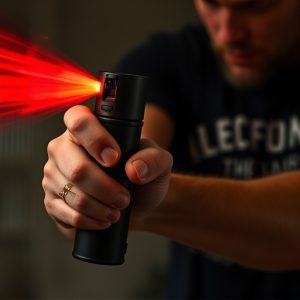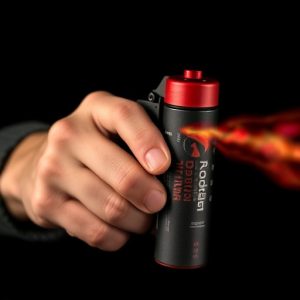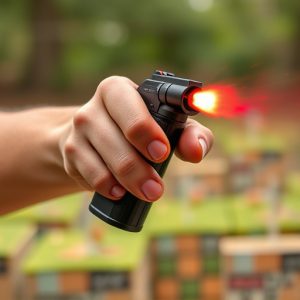Mastering Self-Defense: Tactical Pepper Spray Safety and Effectiveness
To ensure effective and safe self-defense with pepper spray, users should: (1) practice in controlle…….
To ensure effective and safe self-defense with pepper spray, users should: (1) practice in controlled environments using approved training sprayers or old containers to understand spray pattern, range, and activation; (2) select reputable brands that provide detailed product information and quality control measures based on specific needs like intended use, range, impact level, and environmental factors; (3) test pepper spray in outdoor open spaces, aiming at non-living objects to observe range, pattern, and effectiveness; (4) conduct tests at various distances on stationary targets in controlled environments like shooting ranges, simulating different wind conditions with protective gear; (5) regularly review de-escalation techniques and legal standards for ethical self-defense.
Tactical pepper spray is a powerful tool for self-defense, offering a non-lethal means of deterring potential threats. In this comprehensive guide, we’ll explore how to choose and utilize this defense mechanism effectively. From understanding the spray’s composition and its immediate effects to safe handling practices and training tips, you’ll learn the essential steps for testing pepper spray safely. Discover how to make informed decisions and ensure your protection in various situations.
- Understanding Pepper Spray: Composition and Effects
- Choosing the Right Tactical Pepper Spray for Your Needs
- Safe Handling and Testing Procedures
- Practice Makes Perfect: Training Tips for Effective Use
Understanding Pepper Spray: Composition and Effects
Pepper spray, a potent self-defense tool, is designed to incapacitate an attacker temporarily. Comprised of capsaicin, the active ingredient found in chili peppers, it disrupts the nerve signals to the eyes and respiratory system, causing severe discomfort and disorientation. The effects are usually temporary, lasting between 20 minutes to an hour, but can be long enough for you to escape a dangerous situation.
Testing pepper spray safely is crucial to understanding its effectiveness. Users should practice with approved training sprayers or old containers to get accustomed to the spray pattern, range, and activation mechanism. It’s important to note that testing should always be done in a controlled environment, away from other people, to ensure no accidental exposure occurs. This way, you can make informed decisions when choosing a tactical pepper spray for personal protection, ensuring it meets your specific needs and provides the level of safety you require.
Choosing the Right Tactical Pepper Spray for Your Needs
When selecting a tactical pepper spray, understanding your specific needs is paramount. Consider factors like intended use (self-defense, hunting, or law enforcement), desired range and impact level, as well as the environment in which you’ll be using it. Always choose a reputable brand that provides detailed product information and ensures quality control measures.
Safety should never be compromised when testing pepper spray. It’s crucial to practice in a controlled, legal setting where you can ensure proper disposal of used cartridges. Familiarize yourself with local regulations regarding pepper spray use and storage. Additionally, wear protective gear and follow manufacturer instructions during testing to minimize exposure and potential risks.
Safe Handling and Testing Procedures
When handling tactical pepper spray for self-protection, safety should always be your top priority. Before deploying it in an emergency situation, it’s crucial to understand how to test it safely. Start by checking the expiration date and ensuring the canister is intact with no signs of damage or leakage. Next, familiarize yourself with the spray’s activation mechanism. Most modern pepper sprays have a simple trigger, but understanding how it works specifically can help you deploy it effectively during stressful moments.
To Test Pepper Spray Safely, conduct exercises in a controlled environment, preferably an outdoor, open space away from people and sensitive areas. Aim the spray at non-living objects like trees or walls to simulate its range and effectiveness. Observe the spray pattern, distance, and time it takes for the effects to set in. This practical test will help you gauge your response time and understand how far the spray can reach, ensuring you’re prepared should you ever need it for self-defense.
Practice Makes Perfect: Training Tips for Effective Use
When it comes to self-defense, practice makes perfect. Training with tactical pepper spray is essential for ensuring its effective use in real-world scenarios. Start by familiarizing yourself with the spray’s range and duration—knowing how far it reaches and how long its effects last can make a significant difference during an encounter. Practice aim and targeting techniques on stationary objects at various distances to get a feel for the spray’s pattern and spread.
To safely test pepper spray, always follow recommended guidelines. Use a controlled environment like a shooting range or a designated training area. Wear protective gear, including goggles and gloves, to minimize direct contact with the spray. Practice deployment under different conditions—different wind speeds and directions can affect how the spray dissipates and reaches its target. Regularly review de-escalation techniques and understand when and how to use pepper spray as a last resort, ensuring you’re always adhering to legal and ethical standards of self-defense.
Tactical pepper spray can be a powerful tool for self-defense, but proper understanding and practice are key. Remember, knowledge is half the battle won. By learning about different compositions, choosing the right spray for your needs, handling it safely, and practicing regularly, you’ll increase your chances of effectively deterring potential threats. Always prioritize safety when testing pepper spray, ensuring controlled environments and following best practices. With dedication and the right approach, you can become proficient in using this valuable self-defense mechanism.


